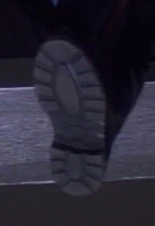(covers information from several alternate timelines)
Footwear referred to types of clothing worn on the humanoid body part, the foot. Typically, footwear came in the forms of shoes and boots. Historically, the practice of making footwear was a role performed by a cobbler or sandal maker. (DS9: "Improbable Cause"; VOY: "False Profits")
Footwear typically prevented unnecessary wear and tear on one's flesh from walking or standing. It could also be used to enhance the performance of certain difficult tasks that one's feet could not normally perform based solely on their genetic ability.
Examples of footwear

An alien boot

Starfleet boot (female, 2370s)

Bottom of a Starfleet boot (male, 2370s)

Polished Mokra Order boots
Starfleet uniforms included regulation black boots. Women's boots usually had somewhat higher heels than the men's. Starfleet uniforms starting in the 2350s included a loop at the bottom of the pant leg, which wrapped around the bottom of the boot to hold it in place.
Aboard an adrift alien starship which lost its artificial gravity, a boot was among the items sliding through a corridor. (ENT: "Anomaly")
In 2269, Spock requested (among other things) a special pair of boots for his trip backwards in time to rescue his younger self. (TAS: "Yesteryear")
Also that year, Leonard McCoy complained about sand in his shoes while traversing the deserts of Lactra VII. (TAS: "The Eye of the Beholder")
One unique design was the footwear of the early-2270s, which was entirely different from any other Starfleet-issue boots. The footwear was the same color as the wearer's uniform, and the female variety had high wedge-type heels. (Star Trek: The Motion Picture)
In 1953, Jimmy claimed that the only way African-Americans would be allowed in space was "if they need someone to shine their shoes". (DS9: "Far Beyond the Stars")
While trapped on Galorndon Core, Geordi La Forge stated to Centurion Bochra that "I never lie when I've got sand in my shoes." (TNG: "The Enemy")
The dog Maura was fond of Geordi La Forge's boots and chewed both boots. (TNG: "Aquiel")
Jake Sisko almost forgot his shoes when he left the quarters for school. (DS9: "The Nagus")
While under the influence of the Saltah'na energy spheres, Jadzia Dax told Kira Nerys "You know what they say - put the shoe on the right foot first, but put the left foot first in the bathtub." Kira seemed confused after this statement. (DS9: "Dramatis Personae")
In 2371, after Tom Paris and Lidell Ren came inside from the cloud burst on Banea, he joked that "there must be a centimeter of water in my boot!" and he tried to take it off, but Lidell began kissing him. (VOY: "Ex Post Facto")
In the Julian Bashir, Secret Agent holoprogram, Julian Bashir has a secret compartment in his shoes where he stores the chamber of a gun. (DS9: "Our Man Bashir")
Kathryn Janeway was able to see a trap when her Alsaurian resistance contact wore polished military boots what identified him as a Mokra Order soldier. (VOY: "Resistance")
Worf apparently chose the color of Jadzia's shoes for their wedding. (DS9: "You Are Cordially Invited")
In the mirror universe, a Klingon officer accidentally lost the key to Garak's bindings. It fell into his boot. (DS9: "Shattered Mirror")
In early 2373, Molly O'Brien obtained a new pair of purple shoes. (DS9: "The Assignment")
In 2378, while The Doctor was forced to impersonate several officers (including Captain Janeway) he hid his mobile emitter under his pant leg on his boot. (VOY: "Renaissance Man")
On Takar II, during Arridor and Kol's reign as "gods", footwear could be traded for goods or services. (VOY: "False Profits")
